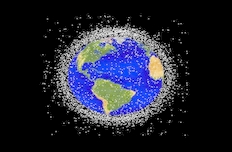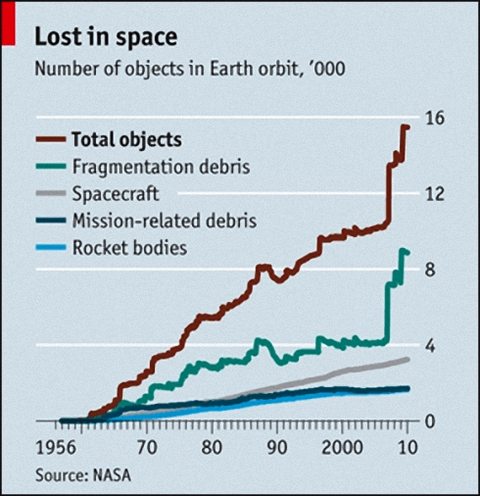Spatial waste
Scientists are increasingly worried about metal fragments flying around the earth's orbit.
February 10, 2009 is an ordinary day like many other days in the 11-year-old life of Iridium 33.

Hundreds of thousands of metal fragments are flying in Earth orbit
This is one of the 66 small satellites that are flying on Earth orbit to receive and transmit signals from satellite phones.
At 3:00 am the same day, a report said: In two hours, Iridium 33 will fly very close, just 600m from another satellite.It is a stopped communication satellite named Cosmos 2251.
It happened exactly, but unfortunately too close.The two satellites bumped into each other, spraying into space hundreds of fragments larger than 10cm in diameter - that is, large enough to detect radar - and only knew how many pieces were too small for radar to see. OK.
Two years before the accident, to test an anti-satellite weapon, the Chinese had destroyed the Fossil - 1C, resulting in the addition of more than 2000 pieces of scrap larger than 10cm in diameter to the sky. with about 35,000 other pieces larger than 1cm in diameter.In total, the two incidents have increased the number of orbiting objects at altitudes of 700-1000km to about a third ( see chart below ).

The aforementioned 700 - 1000km orbit is a low orbit (called LEO - low-Earth orbit), ideal for artificial satellites, because it is relatively easy to launch into orbit; furthermore, the satellite can sweep the surface of the earth in great detail for military and civilian purposes, while satellites can still receive even the weakest signals.
Therefore, not sending satellites into this LEO orbit can be considered a failure. But that is also a danger for satellites on LEO: here, at an average speed of 8km / sec, a piece of metal with a diameter of only 1cm can still damage a satellite, and when the number of pieces of metal type increase, the probability for this incident is higher. And so scrap scrap - a phenomenon called Kessler syndrome, named after American physicist Donald Kessler, who predicted this phenomenon in the 1970s.
According to the European Space Agency (ESA), over the past decade, the number of alarms on satellite touches has doubled. And Nicholas Johnson, head of NASA's orbital debris research division, said that when simulating the path of these debris, we see 'surely Kessler syndrome will happen.' Even the Pentagon's National Security Space Bureau is concerned about whether the amount of scrap available on Earth orbit has already begun to cross the allowable limit.
Because of such concerns, people were more cautious when launching satellites. In particular, the number of satellite explosions due to accidents has decreased over time because the satellite boosters after use are destroyed by low-voltage methods. In addition, after the end of the Cold War, the number of spy satellites also decreased significantly. However, the risk of space scraps remains.
The problem of clearing waste materials in orbit
One danger is clear that satellites currently in orbit will be able to continue to collide. Since the incident of Iridium 33, the Strategic Command (Stratcom) of the US Department of Defense, has been silent for a long time, has begun to enter the war.
According to Brian Weeden, orbital scrap specialist of the Secure World Foundation, Stratcom is now monitoring the sky daily to detect satellites that are too close to each other and alert satellite owners. As a result, satellite owners have better information to make a decision on whether to use satellite fuel to change direction and avoid collisions.
But that is not enough. People need to find a way to clear the waste from the sky. Initiatives to solve orbital scrap problems are as fast as the number of fragments.

There are 11,000 fragments larger than 10cm and 100,000 fragments about 1 - 10cm in size around the earth's orbit.(Photo: NASA)
One proposal, originally made by the US Army 10 years ago, suggested that it could be fired from the ground on 1-10cm diameter debris, vaporizing part of the scrap piece. , causing them to change direction, thus creating a repulsive force large enough to bring them back into the atmosphere and burn. This proposal suggests that just a laser shot can remove all the above-mentioned scrap within three years.
Another solution, proposed by Alliant Techsystems, a company in Minneapolis, is to slow down scrap pieces, so they will burn in the atmosphere. Alliant proposes to build satellites wrapped in spherical layers with light but strong materials. Debris hitting this type of satellite will lose momentum, reduce speed. Large objects, after collisions, will dissolve into very small pieces, not dangerous.
However, many space agencies are paying attention to a third solution: Sending robots to space and assembling used satellites. The robot will fire missiles to propel the satellite to safer orbits or pull the satellite out of its orbit to the sea. Jer-Chyi Liou, a NASA space scrapping specialist, said that five orbiting satellites now have the potential to cause collisions. If by 2020 it is possible to send robots to orbit and clear these 5 satellites, the problem of space scraps will be much less severe.
Punching-ponds?
The European Space Agency ESA also considered this solution. ESA currently owns one of the largest observation satellites in the world, Envisat, which a recent article in SpaceNews magazine said could 'become the most dangerous scrap in space' .

American technicians are working on a satellite monitoring metal fragments that fly on Earth orbit.(Photo: AP)
The above concerns and solutions are good signs for the orbital scrap problem.However, the problem is not simple at all when it comes to military.
Satellites play a vital role in modern warfare.During the war, the satellite explored the battlefield;peacetime, satellites spy on the activities of enemies, opponents, and even suspicious allies.Satellites are communication links.Therefore, in order to defeat each other, it is possible to make each other's satellites live, just like China has tried with Phong Van-1C.
As such, any program that wants to clear the satellite beyond its intended use may touch the military of other countries.Some argue that the anxiety above can be relieved if countries cooperate with each other to decide which country to clean up, because international cooperation will benefit all the countries involved.
- Hue applies GIS to waste collection system
- In the pigeon brain there is a 'space map', so you know where to fly
- How long does it take for plastic waste to decompose?
- Sweden recycles 99% of its waste
- Utilizing food waste - a new mission of biotechnology
- New solution for waste in Vietnam
- Small questions: What is the amount of
- People with good spatial memory are good at sense of smell
- Vietnam is the top 5 countries that discharge most plastic waste into the sea
- Successfully try laser communication for spacecraft
- Garbage is also a resource to take advantage of
- Czech Republic tightens the mandatory classification of waste
 Van Allen's belt and evidence that the Apollo 11 mission to the Moon was myth
Van Allen's belt and evidence that the Apollo 11 mission to the Moon was myth The levels of civilization in the universe (Kardashev scale)
The levels of civilization in the universe (Kardashev scale) Today Mars, the sun and the Earth are aligned
Today Mars, the sun and the Earth are aligned The Amazon owner announced a secret plan to build a space base for thousands of people
The Amazon owner announced a secret plan to build a space base for thousands of people